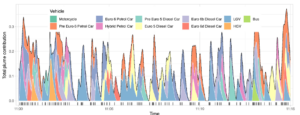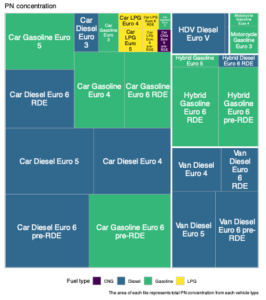Factors controlling near-road exposure to traffic-related air pollutants
For decades, road vehicles have had a considerable impact on urban air pollution and the wider environment. While emissions of many pollutants have decreased significantly over time, there remain important challenges associated with controlling vehicle emissions and quantifying their wider impact on air quality in urban areas. The health evidence continues to support the continued reduction in the concentrations of pollutants such as NO2 and particulate matter. At the same time, vehicle exhaust aftertreatment technologies have become increasingly complex, resulting in emissions of species such as ammonia and nitrous oxide, which are poorly quantified but have important environmental impacts. For pollutants such as particulate matter, the dominant emission is now related to non-exhaust emissions such as tyre and brake wear, which will not be eliminated by switching to electric vehicles (EVs) and hence pose a health risk for decades to come.
While there has been considerable research carried out on measuring real-world vehicle emissions e.g. by instrumenting vehicles or using remote sensing, there has been much less focus on the factors that control near-road exposure to traffic-related air pollutants (TRAPs). The near-road environment is complex due to the multitude of vehicle types affecting the emission of TRAPs and the complexity of how emissions are mixed into the atmosphere. The latter issue is especially poorly characterised but is an important factor controlling near-road exposure to TRAPs (and related health impacts) and is only considered in a rudimentary way in air quality models.

New developments in instrumentation enable the concentrations of important pollutants to be measured at fast response times of less than 1 second, while also requiring low power enabling flexible battery operation. These new instruments open the potential for a much-improved understanding of vehicle emissions and near-road exposure. However, to date there has been little research effort related to the benefits of making measurements at high temporal resolution. Among the potential benefits of such measurements are the development of highly disaggregated vehicle emission factors, the concentration source apportionment of different vehicles, the quantification and influence of vehicle-induced turbulence on near-road exposure and the ability to delineate between nearby and distant sources. New ways of working with the data from these types of measurements are also required if a better understanding is to be developed of the impact of TRAPs in urban areas where exposure is greatest.
The principal aims of this PhD are:
Develop a much-improved understanding of the factors controlling the near-road exposure to important air pollutants using fast time response instruments coupled with highly detailed individual vehicle information. The main aim will be to link emissions measurement with a quantitative understanding of how vehicle plumes are diluted at from the micro-scale for individual vehicles to urban vehicle fleets. New data analysis and statistical methods, involving machine learning methods, will be developed to quantify and separate the role of direct emissions and the influence of vehicle-induced turbulence and compared. Our group has made considerable progress in this area recently, but it is clear there are many more opportunities for research innovation.
The student would work with leading measurement instrumentation available in the Wolfson Atmospheric Chemistry Laboratories to measure a wide range of pollutants such as nitrogen oxides, ammonia, carbon dioxide, methane and particles. A camera and speed-acceleration system will be used to capture individual vehicle information to create a highly detailed database of vehicle information providing excellent opportunities for detailed analysis. Short duration fieldwork to collect primary new data will be conducted throughout the PhD to generate a new evidence base for the research aims of the project.

As part of the PhD, we have the ambition to conduct controlled release experiments where a known quantity of gas is continuously released from a vehicle under a wide range of conditions to develop new insights into the linkage between emissions and near-field dispersion.
It is anticipated that this project will be CASE-supported by Ricardo. The student would have the opportunity to work with those who lead activities related to national and international air quality measurements, the development of the UK National Atmospheric Emissions Inventory and more widely on Ricardo’s own research activities.
Further reading
Farren, N.J… and D.C. Carslaw (2024). An ambient measurement technique for vehicle emission quantification and concentration source apportionment, Environmental Science & Technology, 58, 20091−20100, https://pubs.acs.org/doi/10.1021/acs.est.4c07907.
Wilde, S. E., …, Carslaw, D. C. (2024). Mobile monitoring reveals congestion penalty for vehicle emissions in London. Atmospheric Environment: X, 21, 100241. https://doi.org/10.1016/J.AEAOA.2024.100241.
